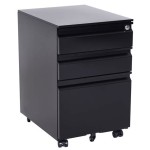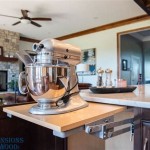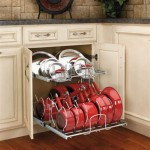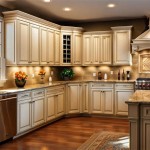How to Wrap Kitchen Cabinets: A Comprehensive Guide
Kitchen cabinets, a focal point in any culinary space, often bear the brunt of daily wear and tear. Over time, they can become outdated, scratched, or simply no longer align with evolving aesthetic preferences. While a full kitchen renovation can be a costly and time-consuming endeavor, wrapping kitchen cabinets presents a viable and more budget-friendly alternative. Wrapping involves applying a self-adhesive vinyl film to the cabinet surfaces, effectively providing a fresh, new look without the need for complete replacement.
This article will provide a detailed guide on how to effectively wrap kitchen cabinets, covering essential preparation steps, material selection, application techniques, and post-application considerations.
Key Point 1: Preparation is Paramount
The success of a cabinet wrapping project hinges significantly on meticulous preparation. This phase ensures proper adhesion of the vinyl film and a smooth, flawless finish. Failure to adequately prepare the cabinet surfaces can lead to bubbling, peeling, and ultimately, an unsatisfactory outcome. The following steps outline the essential preparation process:
1. Removal of Hardware: Begin by removing all cabinet hardware, including handles, knobs, hinges, and any other attached fixtures. This allows for complete access to the cabinet surfaces and prevents obstructions during the wrapping process. Store the removed hardware safely to prevent loss or damage.
2. Thorough Cleaning: Clean the cabinet surfaces thoroughly to remove any grease, dirt, dust, or other contaminants. These substances can interfere with the adhesion of the vinyl film and compromise the longevity of the wrap. Use a degreasing cleaner or a mixture of warm water and mild dish soap. Pay particular attention to areas around handles and frequently touched surfaces, where grease buildup is more likely.
3. Sanding (If Necessary): If the cabinet surfaces are glossy, painted with a high-sheen finish, or have imperfections, sanding is crucial to create a suitable surface for the vinyl film to adhere to. Use a fine-grit sandpaper (around 220-grit) to lightly scuff the surface. This will provide a better "key" for the adhesive to grip onto. After sanding, wipe down the surfaces with a tack cloth to remove any sanding dust.
4. Filling Imperfections: Address any dents, scratches, or imperfections on the cabinet surfaces using wood filler or appropriate patching compound. Apply the filler according to the manufacturer's instructions, allowing it to dry completely. Once dry, sand the filled areas smooth and level with the surrounding surface. Again, remove any dust particles with a tack cloth.
5. Priming (Optional): While not always necessary, applying a primer specifically designed for vinyl wrapping can further enhance adhesion, especially on porous or uneven surfaces. Choose a primer recommended for use with self-adhesive vinyl films and apply it evenly according to the manufacturer's instructions. Allow the primer to dry completely before proceeding with the wrapping process.
6. Surface Inspection: Before applying the vinyl, conduct a final inspection of the cabinet surfaces to ensure they are clean, smooth, and free of any remaining debris. A perfectly prepared surface is the foundation for a professional-looking finished product.
Key Point 2: Material Selection and Cutting
The choice of vinyl film and the precision of the cutting process are critical for achieving a desired aesthetic and a seamless application. Selecting the right material for the project and accurately cutting it to size minimizes waste and ensures a professional-looking result.
1. Vinyl Film Selection: A wide range of vinyl films are available, varying in color, pattern, texture, and thickness. Consider the desired aesthetic and the environment in which the cabinets are located. Thicker films are generally more durable and resistant to scratches and tears, while thinner films are more flexible and easier to work with on complex shapes. Choose a high-quality vinyl film specifically designed for wrapping applications. Look for films that are self-adhesive, repositionable, and durable. Matte finishes are popular for a modern look, while gloss finishes can add a touch of sophistication. Consider the existing decor of the kitchen and choose a vinyl film that complements the overall style.
2. Measuring Cabinet Surfaces: Accurately measure each cabinet surface that will be wrapped, including doors, drawer fronts, and cabinet frames. Add extra material (typically 1-2 inches) to each dimension to allow for overlaps and trimming. It is always better to have too much vinyl than too little. Double-check the measurements to avoid errors.
3. Cutting the Vinyl: Lay the vinyl film flat on a large, clean surface, such as a cutting mat. Use a sharp utility knife or a cutting plotter to cut the vinyl to the measured dimensions. A cutting plotter, if available, provides the most precise and consistent cuts, especially for intricate shapes or patterns. If using a utility knife, employ a ruler or straightedge to ensure straight, clean cuts. Cut the vinyl slightly larger than the measured dimensions to allow for adjustments and trimming during application. For complex shapes or patterns, consider creating a template to guide the cutting process.
4. Labeling the Cut Pieces: Label each cut piece of vinyl to correspond with the specific cabinet surface for which it is intended. This will prevent confusion and ensure that the correct pieces are applied to the correct locations. Use a permanent marker to write the label on the backing paper of the vinyl.
Key Point 3: Application Techniques and Troubleshooting
The application process requires patience, attention to detail, and the right tools. Applying the vinyl correctly prevents air bubbles, wrinkles, and other imperfections that can detract from the final result. Mastering the application techniques and understanding common troubleshooting methods is crucial for a successful wrap.
1. Preparing the Vinyl for Application: Peel back a small portion of the backing paper from the vinyl film, exposing the adhesive. Position the exposed adhesive edge onto the prepared cabinet surface, aligning it carefully with the edges.
2. Applying the Vinyl: Using a squeegee or a similar smooth tool, apply the vinyl to the cabinet surface, working from the center outwards. Use firm, even pressure to smooth out any air bubbles or wrinkles. Gradually peel back the remaining backing paper as the vinyl is applied, continuing to squeegee the surface. Work slowly and methodically, ensuring that the vinyl adheres smoothly and evenly to the surface.
3. Dealing with Air Bubbles: Air bubbles are a common occurrence during vinyl application. Use a pin or a needle to carefully puncture the air bubble, then smooth the vinyl over the punctured area with the squeegee. Work from the edges of the bubble towards the center to release the trapped air.
4. Addressing Wrinkles: Wrinkles can be more challenging to remove than air bubbles. If a wrinkle forms, gently peel back the vinyl from the wrinkled area and reapply it, smoothing out the wrinkle with the squeegee. Use a heat gun or hair dryer on a low setting to gently warm the vinyl, making it more pliable and easier to stretch and conform to the cabinet surface. Be careful not to overheat the vinyl, as this can damage it.
5. Trimming Excess Vinyl: Once the vinyl has been applied to the entire cabinet surface, use a sharp utility knife to trim any excess vinyl around the edges. Cut along the edges of the cabinet, following the contours of the surface. Use a straightedge to ensure clean, straight cuts. Be careful not to cut into the cabinet itself.
6. Wrapping Edges and Corners: Wrapping edges and corners requires careful attention to detail. Use a heat gun or hair dryer to gently warm the vinyl, making it more pliable. Stretch the vinyl around the edges and corners, ensuring that it adheres smoothly and evenly. Use a squeegee to press the vinyl firmly into place. Trim any excess vinyl from the edges and corners, creating a clean, finished look.
7. Post-Application Considerations: After applying the vinyl, allow it to cure for the recommended time period, typically 24-48 hours. This allows the adhesive to fully bond to the cabinet surface. Avoid cleaning the wrapped cabinets with harsh chemicals or abrasive cleaners. Use a mild soap and water solution to clean the surfaces as needed. Inspect the wrapped cabinets regularly for any signs of peeling or damage. If any peeling occurs, reapply the vinyl using the same techniques described above. With proper care, wrapped kitchen cabinets can provide a durable and attractive alternative to traditional cabinet refacing or replacement.
By following these guidelines, individuals can effectively wrap their kitchen cabinets, achieving a refreshed aesthetic without incurring the significant cost and disruption associated with a complete renovation.

How To Vinyl Wrap Kitchen Doors Checkatrade

Everything You Need To Know About Vinyl Wrap Kitchen Cabinet Doors The Door Company

Tutorial How To Wrap Kitchen Cabinets With Cover Styl Adhesive Films Youtube

Tutorial How To Wrap Kitchen Cabinets With Cover Styl Adhesive Films Youtube

What Types Of Laminates Are There To Wrap Cabinet Boxes Redo

How To Wrap Your Kitchen In Vinyl Home

Is It Better To Paint Or Vinyl Wrap Kitchen Cupboards

Tutorial How To Wrap Kitchen Cabinets With Cover Styl Adhesive Films Youtube

Spray Paint Or Vinyl Wrap For Kitchen Cupboards Upvc Painting

How To Wrap A Kitchen Cupboards Countertop Kick Plates Nelcos
See Also








